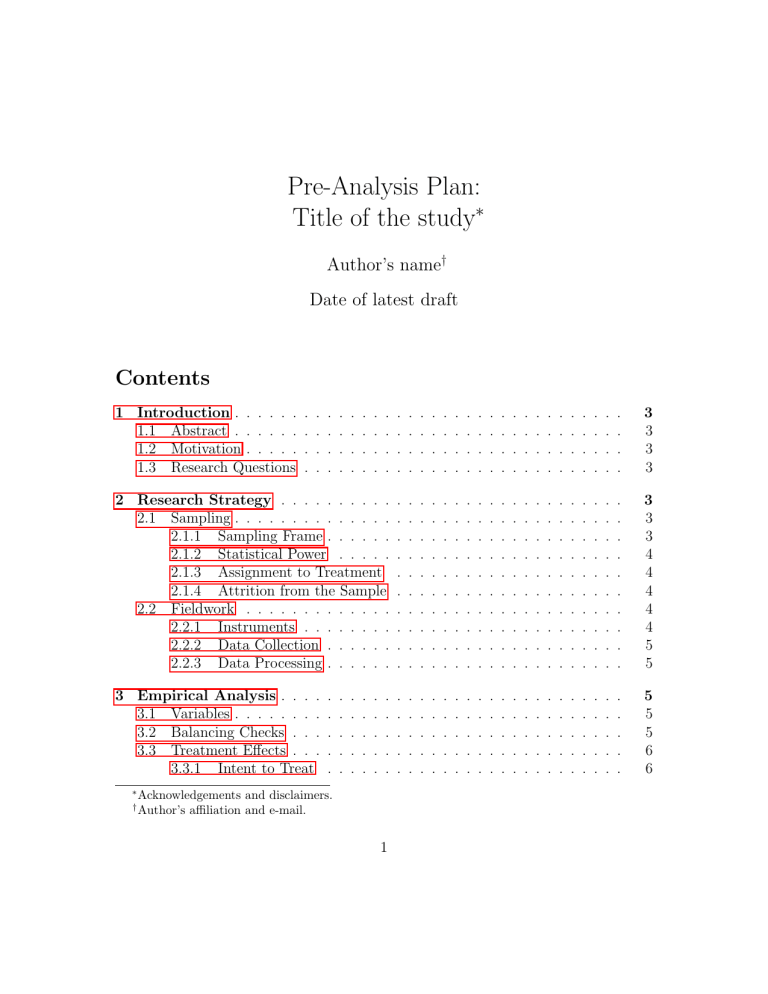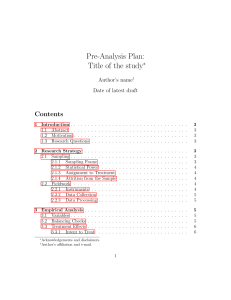
Pre-Analysis Plan: Title of the study∗ Author’s name† Date of latest draft Contents 1 Introduction . . . . . . 1.1 Abstract . . . . . . 1.2 Motivation . . . . . 1.3 Research Questions . . . . . . . . . . . . . . . . . . . . . . . . . . . . . . . . . . . . . . . . . . . . . . . . . . . . . . . . . . . . . . . . . . . . . . . . . . . . . . . . . . . . 3 3 3 3 2 Research Strategy . . . . . . . . . . 2.1 Sampling . . . . . . . . . . . . . . 2.1.1 Sampling Frame . . . . . . 2.1.2 Statistical Power . . . . . 2.1.3 Assignment to Treatment 2.1.4 Attrition from the Sample 2.2 Fieldwork . . . . . . . . . . . . . 2.2.1 Instruments . . . . . . . . 2.2.2 Data Collection . . . . . . 2.2.3 Data Processing . . . . . . . . . . . . . . . . . . . . . . . . . . . . . . . . . . . . . . . . . . . . . . . . . . . . . . . . . . . . . . . . . . . . . . . . . . . . . . . . . . . . . . . . . . . . . . . . . . . . . . . . . . . . . . . . . . . . . . . . . . . . . . . . . . . . . . . . . . . . . . . . . . . . . . . . . . . . . . . . . . . . . . . . . . . . . . . . . . . . . . . . . . . . . . . . . . . . . . . . . . . . . . 3 3 3 4 4 4 4 4 5 5 3 Empirical Analysis . . . . 3.1 Variables . . . . . . . . 3.2 Balancing Checks . . . 3.3 Treatment Effects . . . 3.3.1 Intent to Treat . . . . . . . . . . . . . . . . . . . . . . . . . . . . . . . . . . . . . . . . . . . . . . . . . . . . . . . . . . . . . . . . . . . . . . . . . . . . . . . . . . . . . . . . . . . . . . . . . . . . 5 5 5 6 6 ∗ † . . . . . . . . . . . . . . . . . . . . . . . . . . . . . . . . . . . . . . . . . . . . . . . . . . . . . . . . . . Acknowledgements and disclaimers. Author’s affiliation and e-mail. 1 . . . . . 6 6 6 6 7 4 Research Team . . . . . . . . . . . . . . . . . . . . . . . . . . . . . . . . 7 5 Deliverables . . . . . . . . . . . . . . . . . . . . . . . . . . . . . . . . . . 7 6 Calendar . . . . . . . . . . . . . . . . . . . . . . . . . . . . . . . . . . . . 7 7 Budget . . . . . . . . . . . . . . . . . . . . . . . . . . . . . . . . . . . . . 8 3.4 3.5 3.3.2 Treatment on the Treated Heterogeneous Effects . . . . . . . 3.4.1 Intent to Treat . . . . . . 3.4.2 Treatment on the Treated Standard Error Adjustments . . . 2 . . . . . . . . . . . . . . . . . . . . . . . . . . . . . . . . . . . . . . . . . . . . . . . . . . . . . . . . . . . . . . . . . . . . . . . . . . . . . . . . . . . . . . . . . . . . . . . 1 Introduction 1.1 Abstract • In 1-2 sentences, what does the study entail? • In 1-2 sentences, why is this study important/relevant? 1.2 Motivation • What is the main problem/question motivating the study? • How has this problem/question been addressed thus far? • How is this study different from prior research on this problem/question? • Why is the context that you have chosen for this study appropriate? 1.3 Research Questions • What are the main research questions the study seeks to answer? 2 Research Strategy 2.1 2.1.1 Sampling Sampling Frame • What is the eligible population for the study? – What are the main characteristics of this population? • What is the expected sample for the study? – What is the expected sample size? – How does the expected sample differ from the population? 3 2.1.2 Statistical Power • What is the effect size you will be able to detect? – What are your assumptions about your alpha-level? – What are your assumptions about your statistical power? – What are your assumptions about variability in your effect size? – How many sites will you have? – How many people will you have in each site? – What share of the variance do you expect to predict with your covariates? • How sensitive is your effect size to changes in your parameters? 2.1.3 Assignment to Treatment • How will individuals be assigned to treatment and control conditions? • What is the source of exogenous variation in your study? 2.1.4 Attrition from the Sample • Do you anticipate any form of attrition from the sample? – If so, what share of the sample do you anticipate will attrit? – On what evidence are you basing your expectations about attrition? – How realistic are your expectations about attrition? • What can you do anything to prevent/remedy sample attrition? • How does expected attrition change your power calculations? 2.2 2.2.1 Fieldwork Instruments • What data collections instruments will you employ? – What (groups of) indicators will each instrument cover? – How was each instrument developed? 4 – Have each instrument been used before? – If so, by whom? If not, are you piloting it? – What are the main advantages/disadvantages of each instrument? 2.2.2 Data Collection • How long will the entire data collection process take from start to finish? • What does the data collection entail? • What steps will be take to keep the data collected confidential at this stage? 2.2.3 Data Processing • How long will data processing take from start to finish? • What does the data processing entail? • What steps will be take to keep the processed data confidential? • Who has ownership over the processed data? • How will the data be used/stored after the study at this stage? 3 Empirical Analysis 3.1 Variables • What are the main variables of interest in your study? – How is each of them defined in your dataset? 3.2 Balancing Checks • How will you check balance between treatment and control groups? – What is the specification that you will run? – What variables will you include in these balancing checks? • How will you check balance between attritors and non-attritors? 5 – What is the specification that you will run? – What variables will you include in these balancing checks? 3.3 3.3.1 Treatment Effects Intent to Treat • How will you estimate the (causal) effect of the offer of the treatment? – What is the specification that you will run? – What controls will you include in your specification? 3.3.2 Treatment on the Treated • How will you estimate the (causal) effect of the receipt of the treatment? – What is the specification that you will run? – What controls will you include in your specification? 3.4 Heterogeneous Effects • Which groups do you anticipate will display heterogeneous effects? • What is the broad theory of action that leads you to anticipate these effects? 3.4.1 Intent to Treat • How will you estimate the heterogeneous effects of the offer of the treatment? – What are the specifications that you will run? – What controls will you include in your specification? 3.4.2 Treatment on the Treated • How will you estimate the heterogeneous effects of the receipt of the treatment? – What are the specifications that you will run? – What controls will you include in your specification? 6 3.5 Standard Error Adjustments • How will you account for clustering in your data? • How will you address false positives from multiple hypothesis testing? – If you plan to adjust your standard errors, what adjustment procedure will you use? (e.g., Family Wise Error Rate, False Discovery Rates, etc.) – If you plan to aggregate multiple variables into an index, which variables will you aggregate and how? – How will you deal with outcomes with limited variation? 4 Research Team • Who are the principal investigators of this study? – What will each of these investigators do? • Will there be any research assistants in this study? – If so, what will these research assistants do? 5 Deliverables • What are the main products that will result from this study? • Who will be the lead author(s) for each of these deliverables? 6 Calendar • How long will the entire study take from start to finish? • What are the different tasks/steps to be completed each week/month? 7 7 Budget • What will each part of this study cost? • What sources of funding do you anticipate? 8




